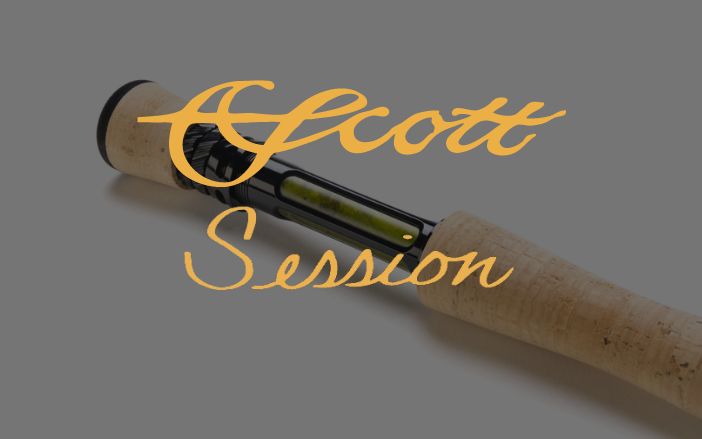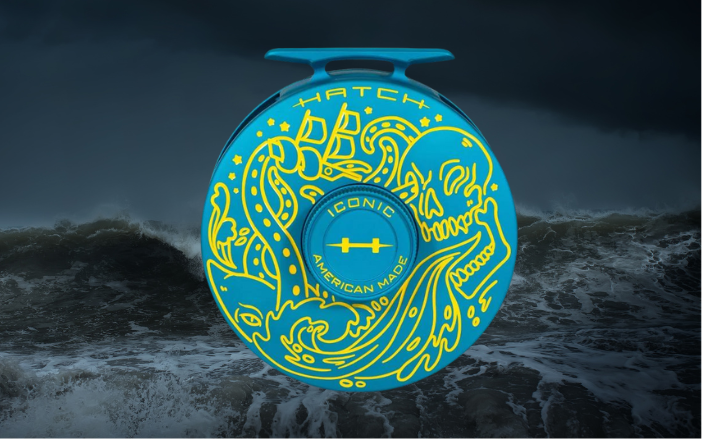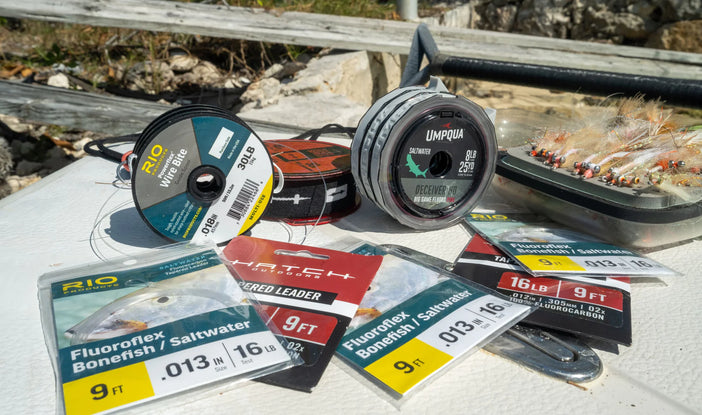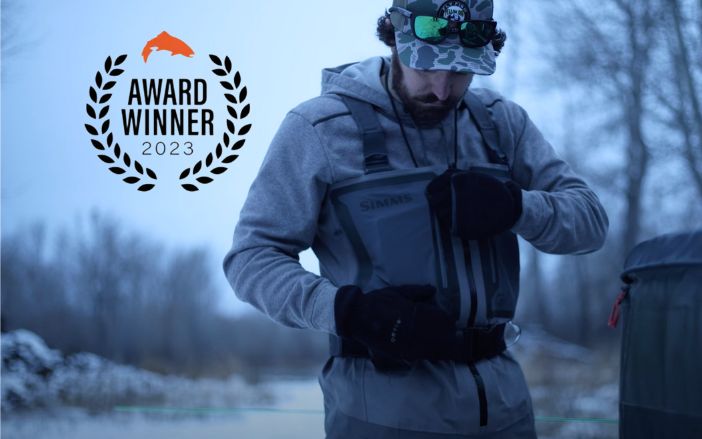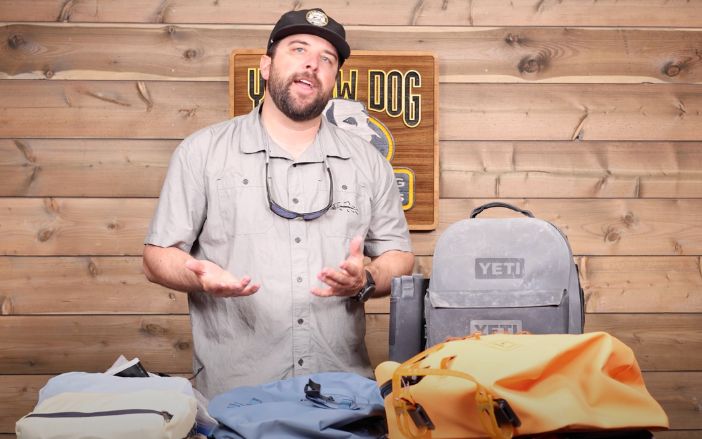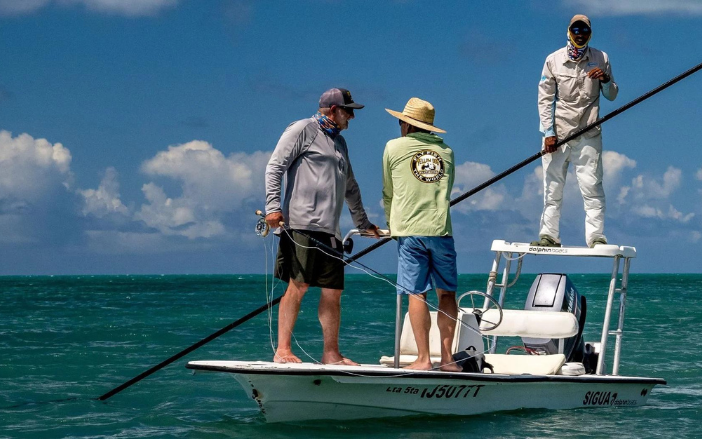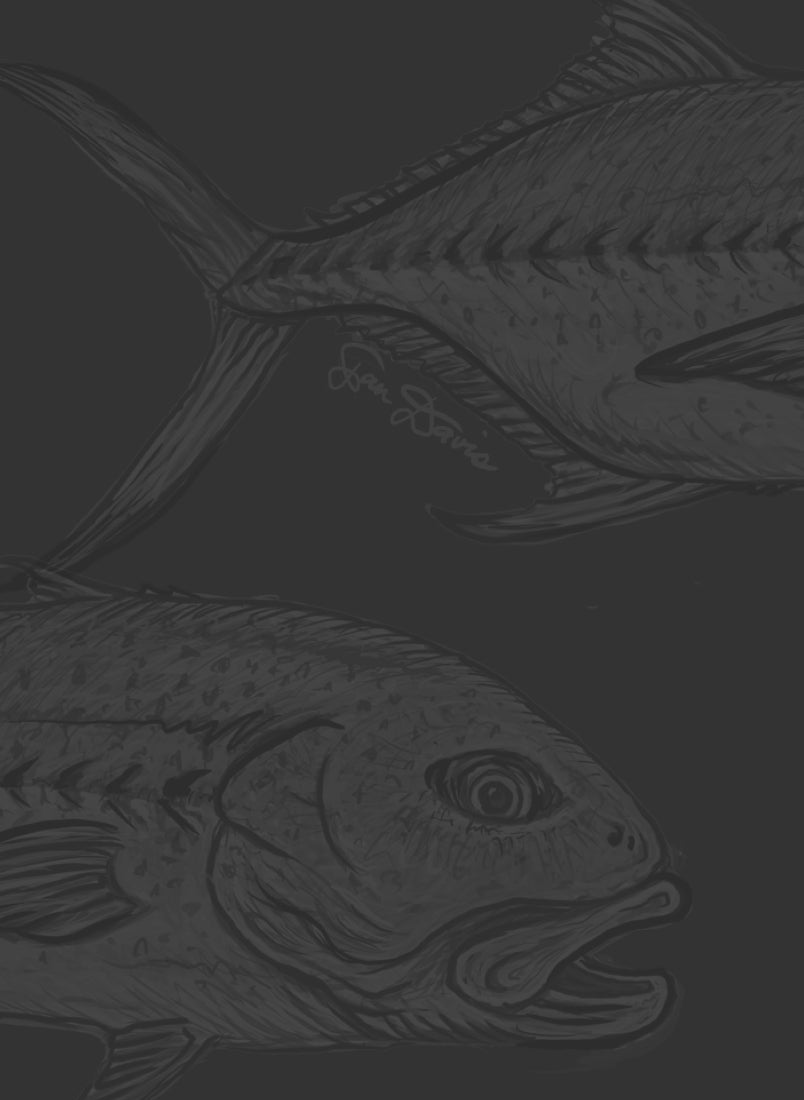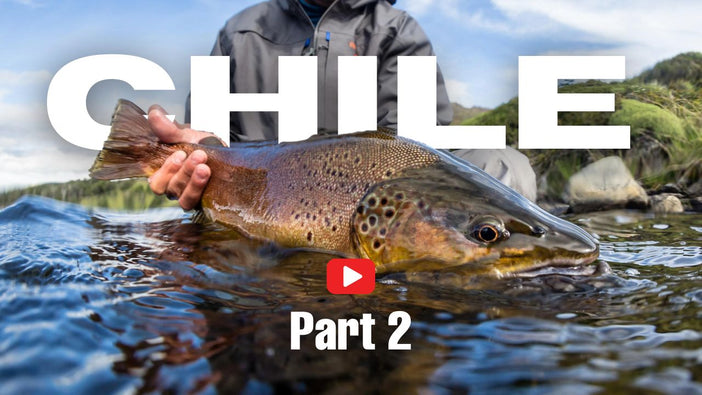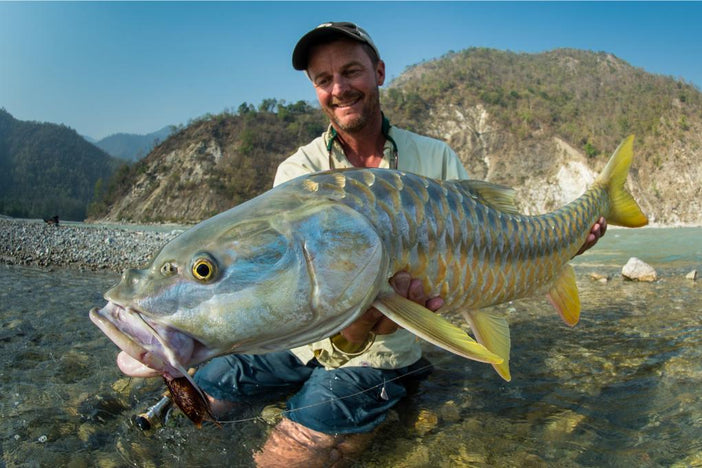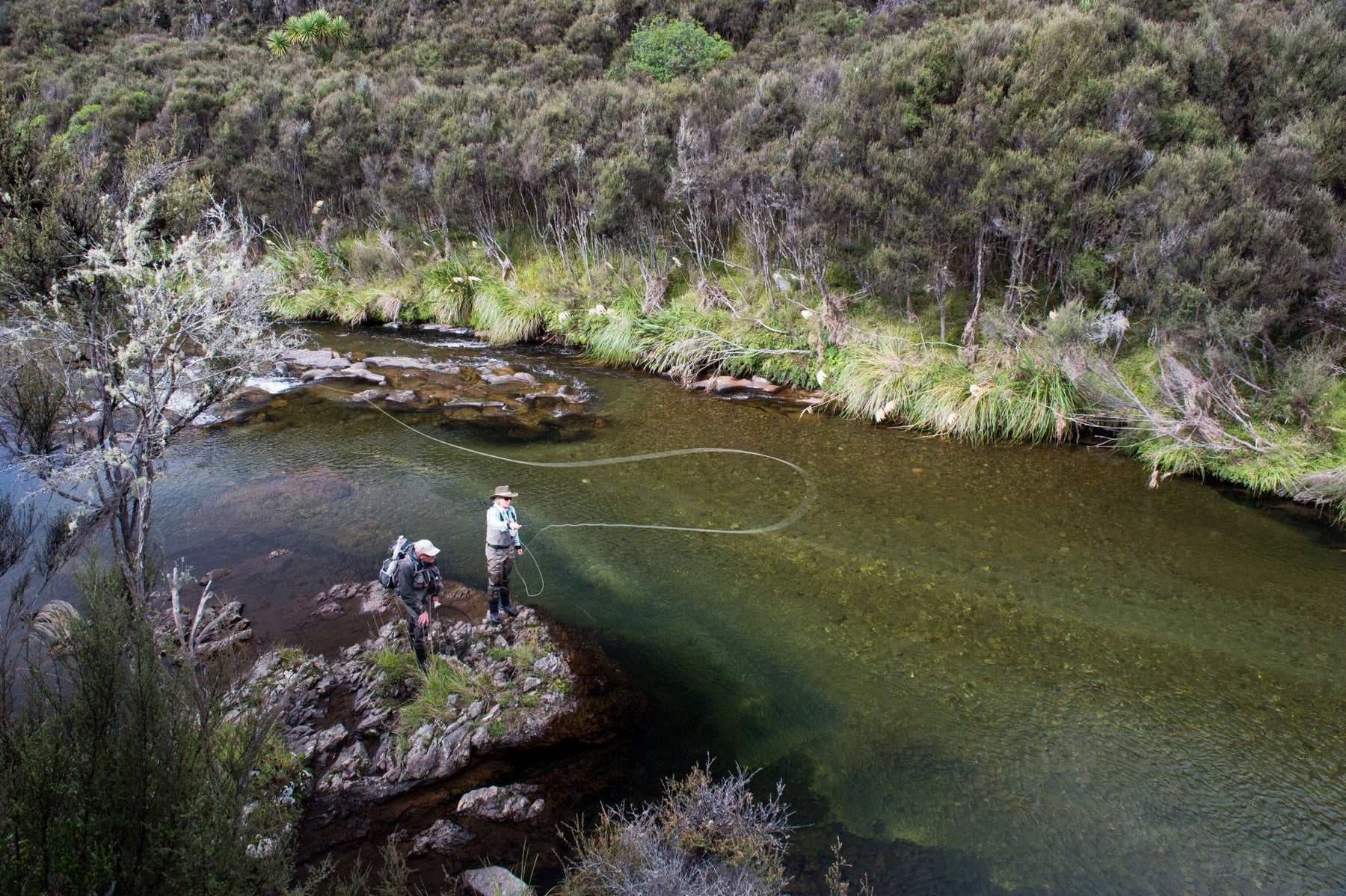You finally make out the silhouette of a brown trout that your guide confidently calls a ten-pounder in the broken blue water immediately in front of you. Several minutes pass as you both silently observe this trophy trout as it feeds. This is your opportunity to capitalize on your good fortune.
You cast your line out on the water and set your small caddis imitation right in its feeding lane! You are ready, and as if on cue, this burly brown trout waves his tail and pokes his nose above the surface as he engulfs your fly in his impossibly large mouth. You heed the advice of your guide by saying “God Save the Queen” just after the fish eats your fly and before you set. That forced delay gives the fish time to chomp down on your fly and as a result, you connect.
All at once, the line becomes tight, ripping up off the water’s surface as the fish realizes his mistake and races downstream through the fast current. In your excitement, and perhaps disbelief, you watch as he torpedoes through the rapids and you suddenly remember that you are at the other end of the line. Your hands stumble as they struggle to bring calm to the chaos unfolding below with your line and reel. You let the fish run and carefully let the line run through your other hand until the fish is on the reel.
But all at once, the line becomes slack and the fish is unquestionably gone!
You look down and see that your fly line has caught around the handle of your reel! A tsunami of horror washes over you, which gives way to anger, followed by grief. How could you allow something so foolish and preventable to happen with such an unforgettable fish? You turn to look back at your guide, perhaps for consolation, but he just shakes his head and laughs, saying “next one, mate.” Somehow, that doesn’t help to alleviate the anguish that has just swallowed you whole.
Here’s the thing: fly fishing for brown trout in New Zealand is not easy. But one must remember that experiencing more challenging fishing scenarios will result in much more significant leaps in angling ability over less time. While many things can go wrong when pursuing wary brown trout in New Zealand, many of these challenges can be avoided with common sense and awareness.
We sat down with Bessie Hudgens to learn about the variables anglers can control when stalking trophy brown trout in New Zealand and how to strategize accordingly.

Before making eye contact: Helpful tips for being stealthy before you even spot a fish
- Make sure you are fishing with dull-colored lines and natural-colored clothing. While you typically pursue trout from downstream, these fish have an impressive peripheral vision and will see that white hat out of the corner of their eyes if you get too close.
- As you walk upriver, looking into the water for that proverbial “shape,” step lightly and avoid talking loudly. Try to walk slowly. The fish feel the vibrations of footsteps on the riverbank, and they can hear you talking about the rugby match last night, too.
- Spotting trout in broken water is difficult at best, so it will behoove you to educate yourself on likely holding spots in addition to utilizing the advice of your guide. The river is full of clues—you just have to know where to look. If a hole looks tempting, give it a once over and then a thrice over. On a blue-sky day, you will be able to eliminate glare on the water’s surface (from the sky) if you look for reflections of mountains, banks, and trees on the water.This will help you see “into” the water more effectively, but of course, you won’t always be able to employ this trick, especially when fishing in an open valley. If you come across a light-colored, flat rock, scan the area around it. Feeding trout often like to position themselves over these kinds of rocks, as they help to silhouette the nymphs drifting from upriver. Brown trout, in particular, like to hold in the intermediate water between the seam and the bank, where the current isn’t too strong and the waves are “bouncing”—they don’t want to work harder than they have to for food. If it looks like it could be a log, maybe it is. But maybe it isn’t?

Target Acquired: How to handle yourself once you’ve spotted a trout in the river
- Take a deep breath. First and foremost. You’ve got this.
- Watch the trout’s body language. Is it actively feeding and swinging around to snatch food out of the feeding lanes? If so, then try to identify what it is eating and how it eats and choose a fly accordingly. Does it look engaged? Or withdrawn? If the fish is sitting near the bottom of the river and moving very little, you might be wasting your time. Try a few weighted nymphs and if that doesn’t rouse the fish from its slumber, go ahead and keep walking.
- Don’t hurry your cast. Analyze your surroundings to look for hazards like logs underwater, beech trees in your back cast, etc. From there, come up with a “game plan” for if and when you hook the fish. Discuss this plan with your guide or, if you are alone, talk to yourself—it may help relax you!
- The presentation is more important than your fly pattern. If you cast a fly very delicately, mend the line quietly, avoid splashes and shadows, and float your fly by the trout with a drag-free drift, you’ve done your job. Be ready for the fish to take your fly!

Fish On: How not to screw it up
- All of those connection points – your fly rod, floating line, leader, tippet and a steel hook - represent potential places where you can encounter gear failure. The angler that makes sure to tie good knots, chose quality gear, and knows a thing or two about setting the hook without ripping off the fish’s mandible, will be in good shape. The most important thing at the beginning of the fight is to maintain tension on the line when the fish makes his first run.
- Line management is essential. Knowing where your line is in those first few seconds of your fight is an easy way to prevent losing a trophy brown trout. Limit your line slack at all costs.
- Maintain steady pressure and do not apply too much power when the fish shakes its head at the end of your line. Be prepared to chase the fish downstream, as that is most likely where he will go. If he boosts for the nearest log jam (because it probably will), take care to turn him away from that snaggy haven without yanking too hard and ripping the hook out.
- Take one more deep breath and remember to be patient. There is no rush to land the fish, and it will forfeit the fight when it’s ready. There is nothing more heartbreaking than having a big fish near the net and losing it because your eagerness to see it in the net caused you to crank up the tension on the rod and pull the hook right out of its mouth. Just try to stay calm throughout the fight, and this will help prevent such tragedies.
When it comes to fishing for brown trout in New Zealand, it helps to be mindful of the fact - if it were easy, everyone would do it, the fish wouldn’t be as big and the experience would not be near as fun or rewarding. What makes brown trout fishing so thrilling is the opportunity to pursue a creature that is in many ways the ultimate freshwater target.
They are big and beautiful, smart and savvy, aggressive yet sensitive, and capable of humiliating you in a way that only makes you want to come back for more. Like mathematics, there is no limit to learning. It’s the greatest game. Better still—you get to play the game in New Zealand, which is arguably the most beautiful sporting arena in the entire world.

Related Articles:
New Zealand Fly Fishing Myths Debunked
Reasons a New Zealand Fly Fishing Trip Is Easier Than You Think
New Zealand Fly Fishing Seasons






